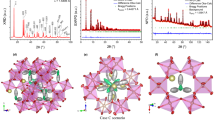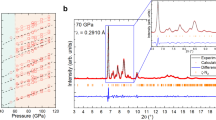Abstract
Knowledge of the ordered atomic structures of crystalline materials is essential in many areas of science. Single-crystal X-ray diffraction is the technique most often used for both solving and refining crystal structures, but recently, powder diffraction methods have become increasingly important. Many structures have been successfully refined with powder data by using the Rietveld profile method1to overcome the problem of overlapping Bragg peaks, but attempts to solve structures ab initio, which require a set of well-resolved Bragg intensities, have proved unsuccessful (with a few notable exceptions2,3). However, a new generation of extremely high-resolution powder X-ray4and neutron5 diffractometers now allows the ab initio determination of crystal structures from powder data (see ref. 6). As part of our study of the structural and magnetic properties of transition-metal phosphates7,8, we present here the structure of α-CrPO4, solved from powder X-ray data obtained at the Brookhaven National Synchrotron Light Source, and confirmed by a Rietveld analysis of neutron data collected with the diffractometer Dla at the Institut Laue–Langevin, Grenoble.
This is a preview of subscription content, access via your institution
Access options
Subscribe to this journal
Receive 51 print issues and online access
$199.00 per year
only $3.90 per issue
Buy this article
- Purchase on Springer Link
- Instant access to full article PDF
Prices may be subject to local taxes which are calculated during checkout
Similar content being viewed by others
References
Rietveld, H. M. J. appl. Crystallogr. 2, 65–71 (1969).
Berg, J.-E. & Werner, P.-E. Z. Kristallogr. 145, 310–320 (1977).
Christensen, A. N., Lehmann, M. S. & Neilsen, M. Aust. J. Phys. 38, 497–505 (1985).
Cox, D. E., Hastings, J. B., Thomlinson, W. & Prewitt, C. Nucl. Instrum. Meth. 208, 573–578 (1983).
Johnson, M. W. & David, W. I. F. Rutherford-Appleton Lab. Rep. No. 85/112 (1985).
Cheetham, A. K. et al. Nature 320, 46–48 (1986).
Battle, P. D. et al. J. Phys. C15, L919–L924 (1982).
Attfield, J. P., Battle, P. D. & Cheetham, A. K. J. Solid St. Chem. 57, 357–361 (1985).
Shafer, M. W. & Roy, R. J. Am. chem. Soc. 78, 1087–1089 (1956).
Frazer, B. C. & Brown, P. J. Phys. Rev. 125, 1283–1291 (1962).
Ronis, M. M. C. r. hebd. Séanc. Acad. Sci., Paris 271C, 64–66 (1970).
Swanson, H. E. et al. Natn. Bur. Stds. (U.S.), 25, 2, 12 (1963).
Hewat, A. W. U. K. Atom Energy Auth. Res. Gr. Rep. No. RRL73/897 (1973).
Cox, D. E. Acta crystallogr. A40, C369 (1984).
Young, R. A. & Wiles, D. B. J. appl Crystallogr. 15, 430–438 (1982).
Author information
Authors and Affiliations
Rights and permissions
About this article
Cite this article
Attfield, J., Sleight, A. & Cheetham, A. Structure determination of α-CrPO4 from powder synchrotron X-ray data. Nature 322, 620–622 (1986). https://doi.org/10.1038/322620a0
Received:
Accepted:
Issue Date:
DOI: https://doi.org/10.1038/322620a0
This article is cited by
-
X-Ray Crystallography and its Role in Understanding the Physicochemical Properties of Pharmaceutical Cocrystals
Journal of the Indian Institute of Science (2017)
-
Crystallography with powders
Nature Materials (2014)
-
Determination of complex structures by combined neutron and synchrotron X-ray powder diffraction
Nature (1992)
-
Determination of valence and cation distributions by resonant powder X-ray diffraction
Nature (1990)
-
The infrared spectra of TiPO4 and VPO4
Journal of Materials Science Letters (1989)
Comments
By submitting a comment you agree to abide by our Terms and Community Guidelines. If you find something abusive or that does not comply with our terms or guidelines please flag it as inappropriate.



